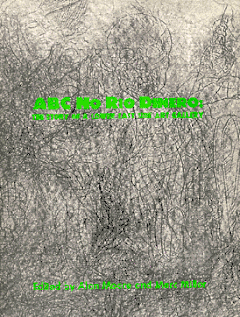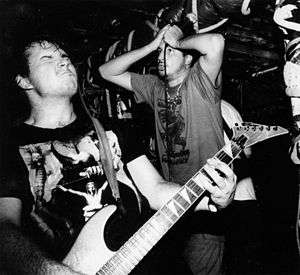ABC No Rio
ABC No Rio is a collectively-run arts organization on New York City's Lower East Side. It was founded in 1980 in a squat at 156 Rivington Street, following the eviction of The Real Estate Show. The centre featured an art gallery space, a zine library, a darkroom, a silkscreening studio, and public computer lab. In addition, it played host to a number of radical projects including weekly hardcore punk matinees and the NYC Food Not Bombs collective.
| ABC No Rio | |
|---|---|
 Cover of the book ABC No Rio Dinero. Cover art by Joseph Nechvatal | |
 | |
| General information | |
| Status | music venue, social centre, squat |
| Address | 156 Rivington Street, New York City |
| Country | USA |
| Coordinates | |
| Owner | ABC No Rio |
| Website | |
| www | |
In July 2016, ABC No Rio vacated the building in advance of demolition and construction of a new facility on the same site for its programs, projects and operations, including the silkscreen studio, zine library, art exhibitions and music shows. The rebuilt structure aims to meet the Passive House standard for energy efficiency.
History
Founding
Beginning in the late 1960s, Manhattan's Lower East Side was facing massive disinvestment by absentee landlords—by the late 1970s up to 80% of the area's housing stock was abandoned and in rem (seized by the city's government for non-payment of taxes). By the late 1970s and 1980s, a growing squatter movement and a small but visible “downtown” arts scene developed from within the burgeoning gentrification of the largely Puerto Rican community in the Lower East Side.[1]
ABC No Rio itself grew out of the 1979 The Real Estate Show, organized by the artists' group Colab (Collaborative Projects), in which a large group of artists seeking to foster connections between these communities occupied an abandoned building at 123 Delancey Street and turned it into a gallery to show solidarity with working people in a critique of the city's land use policies—policies that in essence kept buildings empty until the area again attracted investment from developers—and a demonstration of what can be achieved through solidarity. The show was to explicitly "illuminate no legal issues" and it called for "no rights"; instead, it was "preemptive and insurrectionary." The show opened to the public on January 1, 1980; it was promptly shut down before the morning of January 2 by the New York City Department of Housing Preservation and Development (HPD). In the following negotiations with HPD, the organizers of The Real Estate show were granted the use of the building at 156 Rivington Street. That space became ABC No Rio.[2] The name derives from the remaining letters of a mostly burnt-out Neon sign that was in the front window of the building. It had read: "Abogado Con Notario," which means "lawyer and notary public" in Spanish. But all that remained were the letters "Ab C No rio".[3][4][5]
ABC No Rio was conceived of as an "art-making center," a community-oriented alternative to what its founders perceived as an overly hierarchical art world and gallery scene. It was to be "a place where you could do things that wouldn’t even cross your mind to do in a gallery."[6]
Past legal struggles
| Squatting in the United States | ||||||
|---|---|---|---|---|---|---|
| International context | ||||||
| Legal acquisition | ||||||
|
||||||
| Housing and justice | ||||||
| Notable squats | ||||||
In the negotiations following the occupation of 123 Delancey St, ABC No Rio was given tacit permission to use its current building, located at 156 Rivington Street. ABC No Rio was in legal limbo for decades, sometimes a squat, sometimes paying a small rent to the city. In 1994, the city revoked ABC No Rio's commercial lease and stopped accepting their rent checks. The city planned on selling the building to Asian Americans for Equality for only $4,000. In October 1994, in response to the attempted eviction, a few activists began squatting the upper floors of the building, which had been unused for several years. The squatters' presence stalled the eviction proceedings for several years, along with the community-based protests, which resulted in several arrests. ABC No Rio refused to give up the space and embarked on a project of raising money and reforming their image, to appear to be a more legitimate organization in the eyes of the city.
In 1997, the city agreed to sell the building to ABC No Rio for $1 provided ABC could raise the money to renovate the building and bring it up to code, and that the squatters living in the upper floors of the building vacate to free the space for public use. After three years, the squatters, numbering around 10 and including a young family, left their apartments, which were converted to a zine library, a "Food Not Bombs" kitchen, a silk screening studio, a computer lab, and other artist spaces. Over the years the city changed the scope and price of renovation several times, until 2004 when it was agreed that renovation could be broken into three phases and that the property would be sold when the collective had the funds for phase one in place. On June 29, 2006, the city completed the proposed sale, selling 156 Rivington St. to ABC No Rio for $1, still including the provision that the organization must raise the rest of the money to renovate the building.[7]
Development project
In 2006, having acquired the property the ABC No Rio collective began planning to build a new multi-use arts center with photo darkroom, screenprinting facility, small press library, computer center, expanded space for art, music, performance, educational and community activities, and meeting and office space for ABC No Rio and other organizations.[8]
ABC No Rio's new building was designed by architect Paul Castrucci to meet the rigorous Passive House standard for energy efficiency. It will be significantly more efficient than the state energy code requires, making it a low-energy house. Castrucci commented in 2016 that it would become “one of the most energy-efficient buildings in the city.”[8] In summer 2016, the final shows at the building took place and the collectives found other venues for their activities. The zine library moved to the Clemente Soto Vélez community center and the punk gigs moved to Brooklyn.[9]
Projects
Since 1980, ABC No Rio has hosted many projects. It runs as collective of collectives. The individual projects enjoy a great deal of autonomy in their day-to-day affairs. Building-wide matters are addressed at building collective meetings. Whilst the building itself was being rebuilt, collectives moved to other locations and ABC No Rio collaborated with other groups such as the Museum of Reclaimed Urban Space.[10]
Punk and hardcore

Perhaps ABC No Rio's best known project is the Punk/Hardcore Collective. Since December 1989, ABC No Rio has hosted weekly punk and hardcore matinees on Saturday afternoons. For most of the 1980s, the NYC punk/hardcore scene had been focused around the Sunday matinees at CBGB's. These shows devolved into weekly bloodbaths due to gang violence and, therefore, in November 1989, CBGB's stopped hosting them. The new shows at ABC No Rio were carefully set up to be devoid of the violence, homophobia, sexism, and machismo that took over the CBGB's matinees, and to this day follows a policy of booking only independent (i.e., non-major label) bands that do not in any way promote sexism, racism and homophobia.[11] ABC No Rio is also one of the few places in New York City to host regular punk/hardcore shows that are all-ages.[12]
Zine library
ABC No Rio holds a large collection of zines formerly hosted by the now-defunct Lower East Side radical bookstore and infoshop Blackout! Books. The collection spans over two decades, and features many zines with a radical political perspective, or a focus on punk and other DIY art forms. Some titles include: Love & Rage, Maximum RocknRoll, Profane Existence, Slug and Lettuce, Retard Riot as well as many other less regularly printed or single-issue titles. In 2014, an exhibition at the Center for Book Arts called Zines + the World of ABC No Rio drew on the library collection.[11]
Food Not Bombs
The New York chapter of Food Not Bombs used to cook on the second-floor kitchen of ABC No Rio every Sunday, but now cooks at the Catholic Worker. They continue to serve free food in nearby Tompkins Square Park.[13][14]
See also
Also in New York
References
- Moore, Alan W.; Miller, Marc (1985). ABC No Rio Dinero: The Story of a Lower East Side Art Gallery. Collaborative Projects.
- Max Schumann (ed.) A Book about Colab (and Related Activities) Printed Matter, Inc, 2016, pp.100-119
- Kelefa Sanneh (March 7, 2011). "Fish Tales". The New Yorker.
- James Trimarco (February 6, 2008). "ABC No Rio".
- "ABC No Rio | History". www.abcnorio.org. Retrieved October 22, 2019.
- "BOMB Magazine — ABC No Rio by Shelley Leavitt".
- "For $1, a Collective Mixing Art and Radical Politics Turns Itself Into Its Own Landlord". The New York Times. July 4, 2006.
- Moynihan, Colin (May 16, 2016). "ABC No Rio Gears Up for a Razing and a Brand-New Home". The New York Times. Archived from the original on January 19, 2020. Retrieved January 19, 2020.
- Spanos, Brittany (May 17, 2016). "Iconic Punk Venue ABC No Rio to Close". Rolling Stone. Retrieved January 19, 2020.
- "The Art And Design of No New Jails". Hyperallergic. December 24, 2019. Archived from the original on December 24, 2019. Retrieved January 19, 2020.
- Piepenbring, Dan (August 21, 2014). "The Zines of ABC No Rio". The Paris Review. Archived from the original on April 2, 2019. Retrieved January 19, 2020.
- Erickson, Kevin (January 9, 2008). "Reclaiming New York for Local Arts". Wiretap Magazine. Archived from the original on March 10, 2008. Retrieved January 19, 2020.
- "ABC No Rio | Food Not Bombs".
- "The 30th Anniversary of Food Not Bombs: Part 4 Cooking for Peace in the 21st Century". Food Not Bombs. Retrieved August 19, 2019.
Further reading
Books
- Bagchee, Nandini (2018). "The Collective Making of ABC No Rio (1980–2010)". Counter Institution: Activist Estates of the Lower East Side. Fordham University Press. pp. 153–198. ISBN 978-0-8232-7928-9 – via Project MUSE.
- Alan W. Moore 'ABC No Rio as an Anarchist Space' in (ed) Tom Goyens Radical Gotham: Anarchism in New York City from Schwab's Saloon to Occupy Wall Street (University of Illinois Press, Urbana 2017) 978-0-252-08254-2 pp 201–220
- Alan W. Moore, 'Artists' Collectives: Focus on New York, 1975–2000' in (eds) Blake Stimson & Gregory Sholette Collectivism After Modernism: The Art of Social Imagination after 1945 (University of Minnesota Press, Minneapolis, 2007) pp 204-219
- Max Schumann (ed.) A Book about Colab (and Related Activities) (Printed Matter, Inc.)
External links
| Wikimedia Commons has media related to ABC No Rio. |